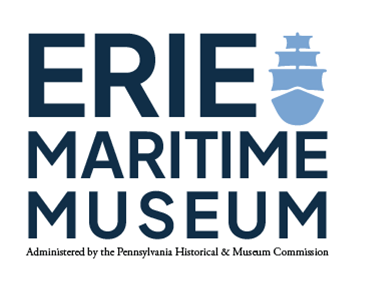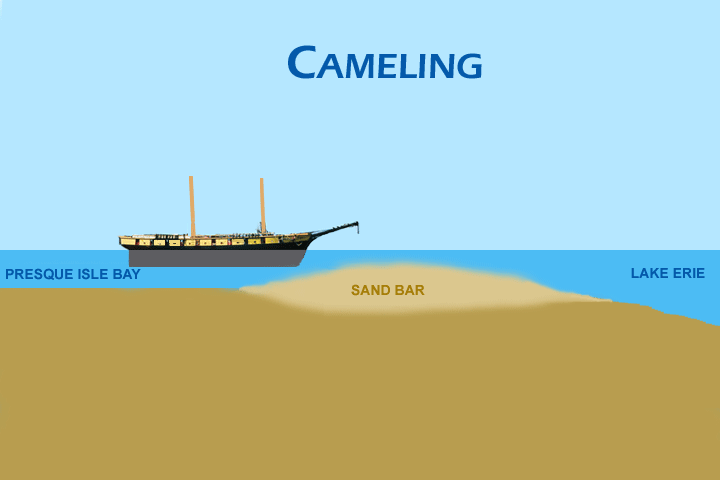Crossing the Bar
Joseph Plavcan, Fort du Presque Isle - Erie Maritime Museum
Many visitors to Erie, PA come to immerse themselves in the astonishing sight of Presque Isle - a peninsula sticking out into Lake Erie which is famous for its breathtaking beaches and location on Erie’s scenic bayfront. Despite its beauty, Presque Isle is more than just a vacation spot, it is a vital part of the story of the Lake Erie squadron, led by Oliver Hazard Perry, as it was built in 1812 and 1813. Presque Isle is a large piece of land with many trees and resources needed to outfit and feed the workers building and defending the squadron over the months they were working. That being said, Erie could provide for little else. Almost all materials and workers for building the Lake Erie squadron had to be transported from other regions of the nation, with iron equipment, such as the cannons and carronades, coming from Pittsburgh or Washington D.C. In fact, the only resource Erie had was the wood needed to build the ships.
According to legend, passed down by the Erie Nation, Presque Isle is a remnant of divine intervention. They spoke of a mighty storm conjured by the lake spirits after the Erie people tried to venture deep into the lake to find the place where the sun sank into the waters. As the storm was coming, the Great Spirit laid out his left arm into the lake to shelter the Eries from the storm. That arm remained there in the shape of a long peninsula wrapping around the area to provide eternal shelter and safe refuge for the Great Spirit’s favorite children, the Erie.
The sheltered harbor created by Presque Isle in Erie was chosen by Daniel Dobbins and the rest of the American shipbuilders for its security. In order for the British squadron to sail within range of the American ships as they were being built, they would have had to bring their ships across a sandbar with only 6 feet of water above it. For the British ships, this was impossible to accomplish, especially without disarming and alerting the American soldiers and marines in place to defend the shipbuilding activities.
However, after months of construction, as 6 of the 9 ships commanded by Oliver Hazard Perry in the Battle of Lake Erie were built in Presque Isle Bay, the Americans were stuck in the same predicament: there was no easy way to sail the squadron over the sandbar that had protected them for so long.
Early Map of Presque Isle “or Erie. Courtesy of the William L. Clements Library, University of Michigan
Courtesy of: U.S. Army Corps of Engineers
The geography of Presque Isle is an interesting component in Erie’s maritime history and is, according to most experts, an anomaly that directly led to people settling here in the first place. For millennia, Presque Isle has been subjected to wave action and constant erosion. In fact, many geologists believe that the “almost island” was originally located three miles to the west of its current location.
In early July 1813, as the American squadron was finishing its preparations and outfitting their battleships, Captain Barclay, commander of the British squadron, set up a blockade at the entrance to Presque Isle Bay to keep an eye on the activities of the American crews. However, on July 31, after weeks of blockading the harbor and exchanging intermittent fire with American gunboats to no effect, Barclay and the British ships were forced to return sail to Canada, most likely to resupply their food stores and armaments. The next day, August 1, 1813, the Americans had their chance to begin leaving Presque Isle Bay and sailing toward battle.
On August 1, at the first chance Perry had, he made preparation to begin taking the newly built ships over the Presque Isle sandbar. Over time before they went out, Perry had his crews mount a number of battery stations on the land overlooking the mouth of the bay to protect the squadron as they were moved over the bar. The first was a water battery mounted with three 12-pound long guns on the beaches. There was also a field battery on Garrison Hill and another where the Erie Land Lighthouse stands today.
As soon as they were able, the smaller gunboats of the squadron made preparations to move over the sandbar. The first step in the process of going over the sandbar is called lightning. Lightening is the removal of as much weight off the boats to increase buoyancy and keep them as high in the water as possible. The main component of lightening is the removal of all guns on board. Once the ships were lightened they could be kedged, which includes taking the ship's anchor out in front of the boat in a small row boat, dropping it, and making the crew haul on the anchor’s line to drag it across. Scorpion and other smaller vessels in the squadron went over the sandbar first using just these two steps, as they were already shallow enough to have little trouble going over the bar.
The next ship to cross the sandbar was Perry’s flagship, Lawrence. The most important aspect of lightening is that all guns on board, 20 in total, had to be removed from the ship and moved to the other side of the bay, where they could be put back on after the ships made it out. This meant that, for the time they were taking Lawrence, and later Niagara, over the bar, they were defenseless except for the shore batteries and what little protection the other ships in the squadron could provide.
Lawrence and Niagara both drafted at about 9 feet in the water, meaning that much of the ship sat beneath the top of the lake. On a typical day, the sandbar at the mouth of Presque Isle Bay had 6 feet of water over it, but on the day Lawrence was supposed to start going over, that level dropped to only 4 to 5 feet of water. That meant that there were about 5 feet of Lawrence’s hull that either needed to be lifted or drug through the bar. To get the brigs over the sandbar and out onto Lake Erie, the sailors used a process called cameling. They had to start by using the same lightening procedure of taking all 20 guns off the ships and having them ready to be put back on. Then, using the Dutch invention of camels, large wooden barges, they brought Lawrence across the bar. The camels used by Perry’s squadron were 50 feet long, 10 feet wide, and 8 feet deep, placing two on both sides of the ship for a total of 4 camels. They had holes in the bottom with plugs to let water in enough to sink them to a point where wooden poles could be slotted into the sweep ports of Lawrence, and later Niagara. After the camels were attached to the ship, sailors worked to pump water out of the barges, which then lifted the ship with them. Lawrence was lifted about two feet, then had to be lifted again with the same process to be able to get over the bar. Using the same kedging technique as was utilized with the smaller vessels, Lawrence was hulled over the sandbar by spinning the capstan to pull on the anchor that had been dropped on the outside of the sandbar by a rowboat. The whole process for Lawrence took just under two days to complete.
Courtesy of Peter Rindlisbacher, “Cameling the Brigs”
The following day, August 5, the process was repeated again, this time to carry Niagara over the sandbar. After learning the process of cameling and gaining the experience of doing it once, bringing Niagara over was much easier. In addition, the water level over the bar had returned to normal and Lawrence had been dragged through the top. As Niagara was in the process of coming over the bar, the British squadron, under Robert Barclay, came sailing into view. They came no closer than 7 miles away from the Presque Isle and Perry’s squadron. Apparently, dense fog and tree cover along the shoreline prevented the British from seeing how defenseless the Americans were, and they soon turned around and sailed back towards their homeport, with the American vessel Ariel following them briefly to make sure they continued away. All in all, Niagara and the rest of Perry’s squadron were across the sandbar, refitted with their guns, and on their way into Lake Erie by August 6, 1813.
Overall, the process of cameling over the sandbar at Presque Isle Bay was one of the most intuitive, and challenging, aspects of the events on Lake Erie in 1812 and 1813. The ingenuity of the crew and the support they had from experts and the navy proved vital for the American war effort and the victory of the Lake Erie Squadron on September 10, 1813.
Courtesy, Timothy McLaughlin, “Animation: Cameling”
Bibliography
Knoll, RADM Denys W. “Battle of Lake Erie: Building the Fleet in the Wilderness.” Naval
Historical Foundation. 1979. https://www.navyhistory.org/battle-of-lake-erie-building-the-fleet-in-the-wilderness/.
Pennsylvania Department of Conservation & Natural Resources. “History of Presque Isle.”
Presque Isle State Park. History of Presque Isle State Park.
Rosenberg, Max. The Building of Perry’s Fleet on Lake Erie, 1812-1813. Harrisburg:
Pennsylvania Historical and Museum Commission, 1997.
Rybka, Walter. The Lake Erie Campaign of 1813: I Shall Fight Them This Day. The History Press, 2013.
Sigmund, Chris. “Crossing the sandbar.” Erie Times-News.






